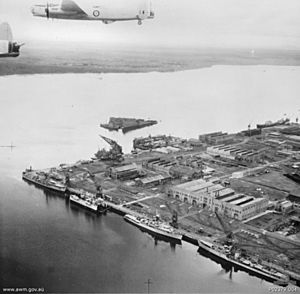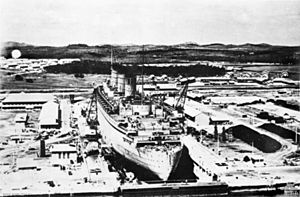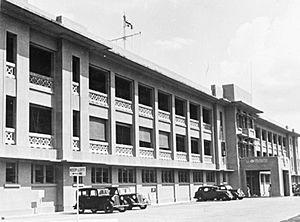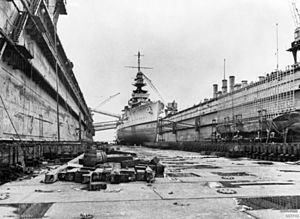Singapore Naval Base facts for kids
Quick facts for kids HMNB Singapore |
|
|---|---|

An aerial view of the Singapore Naval Base on June 1953 from RAAF Avro Lincoln bombers.
|
|
| Active | 1938–1958 |
| Country | |
| Branch | |
| Type | Naval base |
| Part of | Royal Navy |
His Majesty's Naval Base, Singapore, also known as the Singapore Naval Base or HMS Sembawang, was a very important naval base for the Royal Navy (the British navy) in Singapore. It was located in Sembawang, at the northern tip of Singapore. This base was a key part of Britain's defense plans in Asia between the two World Wars.
From 1921 to 1941, it served as a base for the China Station. During World War II, from 1941 to 1945, it was used by the Imperial Japanese Navy for repairs. After the war, from 1945 to 1958, it became a base for the British Far East Fleet. Today, it is a commercial shipyard, but the British military still has a small presence there.
Contents
For a long time, the British government used four main military bases around the world to control the oceans. These were in the North Atlantic: Bermuda and Halifax, Nova Scotia (Canada), and in the Mediterranean Sea: Gibraltar and Malta.
These bases were mostly for dealing with other European navies. But after World War I, a new threat appeared: the growing navy of the Japanese Empire. Britain realized it needed a strong naval base in Asia to protect its interests and act as a warning to Japan.
Building the "Gibraltar of the East"
So, in 1923, Britain decided to build a huge naval base on Singapore Island. The construction was slow at first. But when Japan invaded Manchuria in 1931, the work sped up.
The base was finished in 1938. It cost a massive £60 million, which would be billions of pounds today! It covered a huge area of 21 square miles (54 square kilometers). It had the world's largest dry dock at the time, which is like a giant bathtub for repairing ships. It also had enough fuel tanks to supply the entire Royal Navy for six months.
The base was protected by powerful 15-inch naval guns at places like Johore battery and Changi. Smaller guns were at Fort Siloso and Fort Canning. Air defense was provided by the Royal Air Force (RAF) from airfields at RAF Tengah and RAF Sembawang. Winston Churchill, a famous British leader, even called it the "Gibraltar of the East" because it was so strong.
On January 1, 1940, the base's name was changed from HMS Terror to HMS Sultan. This was to honor the nine sultanates (kingdoms) on the nearby Malay Peninsula.
What Happened During World War II?
When British Malaya (now Malaysia) fell to the Japanese army on January 31, 1942, Singapore came within range of Japanese artillery. The Japanese army was ready to capture Singapore very quickly.
The Japanese army soon captured the naval base, mostly undamaged. It became the Imperial Japanese Navy's No. 101 Repair Facility. They used it to fix their ships throughout World War II. Even German and Italian submarines used it for supplies.

The Base Returns to British Control
After Japan surrendered in August 1945, the British and Commonwealth forces took back control of the naval base and Singapore in September 1945.
The living quarters next to the base were named HMS Terror from 1945 to 1971. This was in honor of a warship named HMS Terror that had been based in Singapore before the war. Today, part of this area is used by the Republic of Singapore Navy's Naval Diving Unit.
Who Uses the Base Today?
In 1971, the British military completely left Singapore. The naval base was then given to the Singapore government. In 1968, it was turned into a commercial shipyard called Sembawang Shipyard.
Continued Presence of Other Countries
Even after the British left, some other countries kept a military presence.
- New Zealand: From 1971 to 1989, New Zealand had a military force called NZFORSEA based in Singapore. They had soldiers, helicopters, and frigates (warships) there. This was the last major foreign military presence in Singapore.
- United Kingdom: The British Ministry of Defence still keeps a small logistics base at Sembawang wharf. This base helps repair, refuel, and resupply ships from the Australian, British, and New Zealand navies, as well as other countries from the Commonwealth of Nations.
- United States: Since 1992, American military forces, mainly the navy and air force, have used the base facilities. The Commander, Logistics Group Western Pacific, is based here. They provide support for the US 7th Fleet's operations in the Pacific and Southeast Asia. The US Air Force also has a support unit here.
- India: Since 2002, Singapore has allowed the Indian Navy to use Sembawang Port. Indian patrol boats also help escort American naval ships through the Straits of Malacca.
Important Parts of the Base
Admiralty IX Floating Dry Dock
This was a very large floating dry dock, the third-largest in the world when it was built. It could be moved and was used to repair big ships like the aircraft carrier HMS Eagle in 1939.
King George VI Graving Dock
This was another type of dry dock, completed in February 1938. It was over 300 meters (980 feet) long and was the largest dry dock in the world at that time. When the Japanese army was about to capture Singapore in 1942, the British destroyed parts of this dry dock to prevent the Japanese from using it. However, the Japanese repaired it and used it during the war. The Allies later bombed it to try and stop the Japanese from using it.
Images for kids



